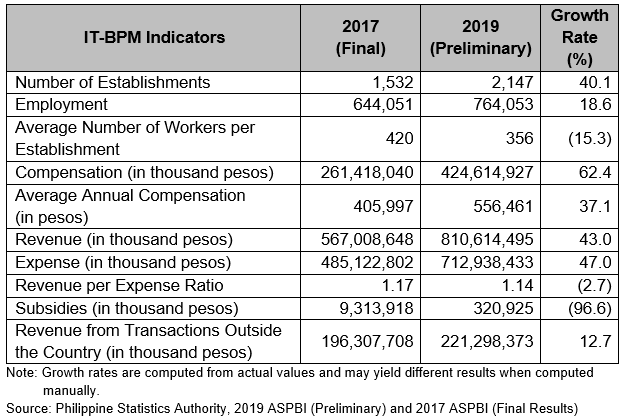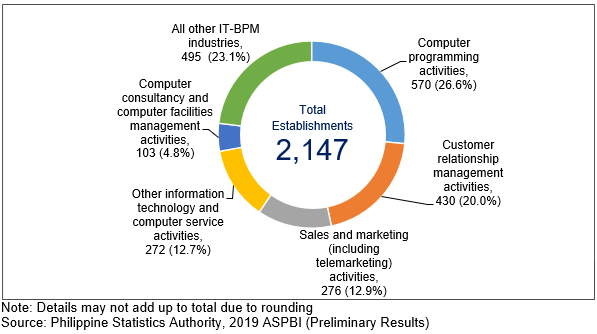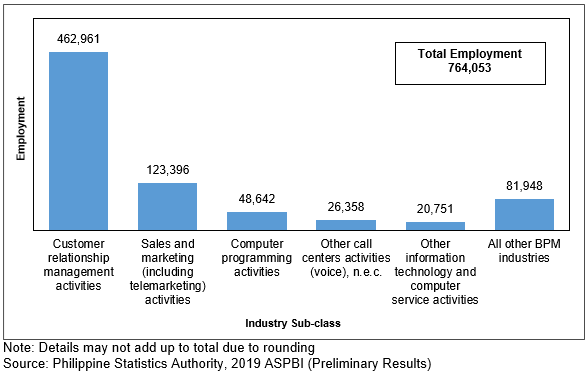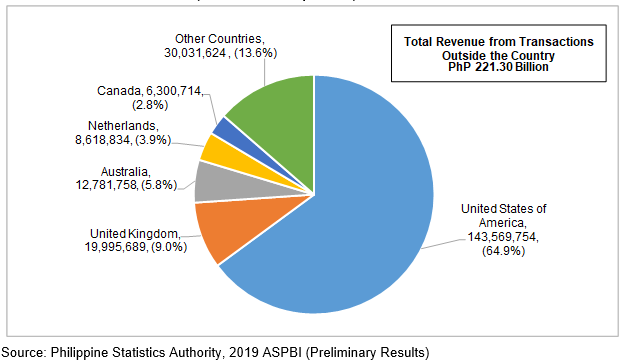Table A. Comparative Summary Statistics for Information Technology - Business Process Management (IT-BPM) Establishments: Philippines, 2019 and 2017

Information Technology – Business Process Management (IT-BPM) covers selected industries in the Information and Communication (Sector J) and Administrative and Support Service Activities (Sector N) sectors. IT-BPM services refer to provision of a bundled service package that combines information technology-intensive services with labour (manual or professional depending on the solution), machinery and facilities to support, host and manage a business process, such as financial transaction processing, credit card processing, payment services, such as benefits administration, payroll processing, personnel administration; supply chain management business processes, such as inventory management, procurement services, logistics services, production scheduling and order processing; customer relations management business processes, such as help desk, call center, customer service; vertical market business processes, conducted by specific industries such as electric, chemical, petroleum; and other business processes for client (Central Product Classification version 2.1 (CPC v2.1) United Nations Statistical Division (UNSD)).
This Special Release on IT-BPM is based on the preliminary results of the 2019 Annual Survey of Philippine Business and Industry (ASPBI) and 2017 ASPBI final results.
Computer programming activities recorded the highest in terms of number of establishments
The Annual Survey of Philippine Business and Industry (ASPBI) preliminary results showed that a total of 2,147 establishments in the formal sector of the economy were engaged in IT-BPM activities in 2019. This level is higher by 40.1 percent compared with the 1,532 IT-BPM establishments recorded in 2017. (Tables A and 1, Figure 1)
Among the industry sub-classes, computer programming activities with 570 establishments or 26.6 percent of the total recorded the highest number of establishments. This was followed by customer relationship management activities with 430 establishments (20.0%) and sales and marketing (including telemarketing) activities with 276 establishments (12.9%). (Table 1 and Figure 1)
Figure 1. Percentage Distribution of IT-BPM Establishments
by Industry Sub-class: Philippines, 2019

Majority of the workers were employed in customer relationship management activities
Total employment generated by IT-BPM industries reached 764,053 in 2019, indicating an increase of 18.6 percent compared with the 644,051 workers reported in 2017. Of the total, 763,063 workers or 99.9 percent were paid employees and the remaining were working owners and unpaid workers. (Tables A and 1)
Among IT-BPM industries, customer relationship management activities employed the highest number of workers of 462,961 or 60.6 percent of the total. Sales and marketing (including telemarketing) activities came second with 123,396 workers (16.2%), while computer programming activities ranked third with 48,642 workers (6.4%). (Table 1 and Figure 2)
Figure 2. Distribution of Employment of IT-BPM Establishments
by Industry Sub-class: Philippines, 2019

The IT-BPM industries recorded an average of 356 workers per establishment in 2019. (Tables A and 2)
Customer relationship management activities led with an average of 1,077 workers per establishment. On the other hand, on-line employment placement agencies recorded the lowest with an average of 39 workers per establishment. (Table 2)
Administrative support activities paid the highest average annual compensation
In 2019, the total compensation paid by IT-BPM industries to its employees amounted to PhP 424.61 billion. This translates to an average annual compensation of PhP 556.46 thousand per paid employee. Compared with the average annual pay of PhP 406.00 thousand per paid employee in 2017, this value indicates an increase of 37.1 percent. (Tables A, 1, and 2)
By industry sub-class, administrative support activities paid the highest average annual compensation of PhP 1.48 million per paid employee. This was followed by application hosting services and web portals, and software publishing with PhP 1.35 million and PhP 1.31 million per paid employee, respectively. (Table 2 and Figure 3)
Figure 3. Average Annual Compensation of Paid Employees
for Top Five Industries of IT-BPM Establishments
by Industry Sub-class: Philippines, 2019

Customer relationship management activities tops in revenue and expense
IT-BPM industries earned a total revenue of PhP 810.61 billion and incurred a total expense of PhP 712.94 billion in 2019. These values recorded growth rates of 43.0 percent and 47.0 percent from their respective 2017 values. (Tables A and 1, Figure 1)
More than half of the shares to total revenue and total expense were accounted for by customer relationship management activities with PhP 446.50 billion revenue (55.1%) and PhP 396.46 billion expense (55.6%). (Table 1 and Figure 4)
Figure 4. Revenue and Expense for IT-BPM Establishments
by Industry Sub-class: Philippines, 2019


In 2019, IT-BPM industries generated a revenue per peso expense of 1.14. This means that for every peso spent, a corresponding revenue of 1.14 pesos was generated. (Tables A and 2)
Among the industry sub-classes, data processing recorded the highest revenue per peso expense of 2.46. On-line employment placement agencies and supply chain management activities followed with revenue per peso expense of 1.69 and 1.25, respectively. (Table 2)
Government granted PhP 320.93 million subsidies
Subsidies are grants received from the government in the form of financial assistance or tax exemption to aid and develop an industry. The government granted PhP 320.93 million subsidies in 2019, much lower by -96.6 percent than the PhP 9.31 billion subsidies provided for the industry in 2017. (Tables A and 1)
Among industry sub-classes, sales and marketing (including telemarketing) activities received the highest subsidies of PhP 239.89 million. The following industries also received subsidies in 2019:
a. Customer relationship management activities, PhP 64.58 million;
b. Computer programming activities, PhP 8.73 million; and
c. Data processing, PhP 7.73 million. (Table 1)
United States of America (USA) contributed most of the revenue from transactions outside the country
IT-BPM industries earned a revenue of PhP 221.30 billion from transactions outside the country, which is equivalent to 27.3 percent of the industry’s total revenue in 2019. This amount is higher by 12.7 percent from the PhP 196.31 billion revenue generated from transactions outside the country in 2017. (Tables A and 1)
Among the countries, the United States of America (USA) had the highest share of 64.9 percent to the total income from transactions outside the country amounting to PhP 143.57 billion. (Tables A and 3, Figure 5)
Figure 5. Percentage Distribution of Revenue from Transactions Outside the Country for IT-BPM Establishments by Industry Sub-class Philippines (in thousand pesos), 2019

Industry-wise, customer relationship management activities had the highest income from transactions outside the country amounting to PhP 104.12 billion (47.1%). This was followed by computer programming activities, and finance and accounting activities with PhP 31.40 billion (14.2%) and PhP 21.61 billion (9.8%), respectively. (Table 3 and Figure 6)
Figure 6. Total Revenue and Revenue from Transactions Outside the Country of the Top Five Industries of IT-BPM Establishments
by Industry Sub-class: Philippines, 2019

DENNIS S. MAPA, Ph.D.
Undersecretary
National Statistician and Civil Registrar General
TECHNICAL NOTES
I. Introduction
This Special Release presents the final results of the 2019 Annual Survey of Philippine Business and Industry (ASPBI) for Information Technology - Business Process Management (IT-BPM) industries. IT-BPM is composed of selected industries of Information and Communication (Sector J) and Administrative and Support Service Activities (Sector N).
The ASPBI is one of the designated statistical activities of the Philippine Statistics Authority (PSA). Data collected from the survey provide information on the levels, structure, performance, and trends of economic activities of the formal sector in the entire country for the year 2019.
The conduct of the 2019 ASPBI is authorized under Republic Act 10625 known as the Philippine Statistical Act of 2013 which mandates reorganizing and strengthening of the Philippine Statistical System (PSS), its agencies and instrumentalities.
II. Data Collection and Processing
The survey was conducted nationwide in 2020 with the year 2019 as the reference period, except for employment whose reference period is as of 15 November 2019.
Sample establishments were given various options in accomplishing the survey questionnaire. These were the following:
online questionnaire available at https://aspbi.psa.gov.ph;
electronic copy of the questionnaire either in portable document format (.pdf) or Excel (.xlsx) file format; and
printed copy of the questionnaire.
The Establishment Data Management System (EDMS) was utilized in the decentralized processing of 2019 ASPBI questionnaires in the provinces.
Data are presented by industry group or 3-digit as classified under the 2009 Philippine Standard Industrial Classification (PSIC).
III. Taxonomy of Establishments
An establishment is defined as an economic unit under a single ownership or control which engages in one or predominantly one kind of economic activity at a single fixed location.
An establishment is categorized by its economic organization, legal organization, industrial classification, employment size, and geographic location.
Economic Organization refers to the organizational structure or role of the establishment in the organization. An establishment may be single establishment, branch, establishment and main office with branches elsewhere, main office only, and ancillary unit other than main office.
Legal Organization refers to the legal form of the economic entity which owns the establishment. An establishment may be single proprietorship, partnership, government corporation, stock corporation, non-stock corporation, and cooperative.
Industrial classification of an economic unit was determined by the activity from which it derives its major income or revenue. The 2009 PSIC which was approved for adoption by government agencies and instrumentalities through PSA Resolution No. 01 Series of 2017-158 signed on 14 February 2017 was utilized to classify economic units according to their economic activities.
Size of an establishment is determined by its total employment as of the time of visit during the latest Updating of the Establishments.
Total Employment (TE) refers to the total number of persons who work in or for the establishment. This includes paid employees, working owners, unpaid workers and all employees who work full-time or part-time including seasonal workers. Also included are persons on short term leave such as those on sick, vacation or annual leaves and on strike.
Geographic Classification refers to the grouping of establishments by geographic area using the Philippine Standard Geographic Code (PSGC) classification. The PSGC contains the latest updates on the official number of regions, provinces, cities, municipalities, and barangays in the Philippines. The PSGC as of 31 December 2019 was used for the 2019 ASPBI.
IV. Scope and Coverage
The 2019 IT-BPM covered establishments from selected industries of Information and Communication (J) and Administrative and Support Service Activities (N) sectors classified under the 2009 PSIC.
Below is the list of IT-BPM industries.


The survey was confined to the formal sector of the economy, which consists of the following:
1. Corporations and partnership
2. Cooperatives and foundations
3. Single proprietorship with employment of 10 and over
4. Single proprietorships with branches
Hence, the 2019 ASPBI covered only the following economic units:
All establishments with total employment (TE) of 10 or more, and
All establishments with TE of less than 10, except those establishments with Legal Organization = 1 (single proprietorship) and Economic Organization = 1 (single establishment), that are engaged in economic activities classified according to the 2009 Philippine Standard Industrial Classification (PSIC).
V. Sampling Design
The 2019 ASPBI uses stratified systematic sampling design with 3-digit or 5-digit PSIC as the first stratification variable, depending on the sector, and total employment, which is classified into Micro, Small, Medium establishments (MSME), as the second stratification variable.
Stratified systematic sampling is a process of dividing the population into homogeneous groups, called strata, and then selecting independent samples in each stratum systematically. This method ensures that all important subgroups of the population are represented in the sample and increases the precision of “overall” survey estimates.
Domain
The geographic domain of the 2019 ASPBI is region. The industry domain/stratum is 3-digit or 5-digit industry classification, and the employment domain/stratum is the MSME classification.
Unit of Enumeration
The unit of enumeration for the 2019 ASPBI is the establishment.
Sampling Frame of Establishments
The sampling frame for the 2019 ASPBI was extracted from the preliminary 2019 List of Establishments (LE) as of 05 February 2020. This frame was used to draw the sample establishments for the survey. The preliminary 2019 LE shows that there were 1,000,524 establishments in operation in the country of which 336,712 establishments comprised the sampling frame or the establishments that are within the scope and coverage of the 2019 ASPBI.
Estimation Procedure
1) Estimation of Survey Weights
Base Weight
The base weight is the inverse of the probability of selection. For the ASPBI, the base weight for each domain is given by:

where:
whk= weight of the kth establishment in the hth stratum
Nh = total no. of establishments in the hth stratum
nh = total no. of sample establishments in the hth stratum
h = refers to the industry-employment stratum
Adjustment Factor
To take into account the non-responding sample establishments, the adjustment factor by region and industry domain is as follows:

where:
As = adjustment factor for industry domain s
X1k = eligibility status of the kth sample establishment (1 if eligible, 0 otherwise)
X2k = responding status of the kth sample establishment (1 if responding, 0 otherwise)
Final Weight
The final weights is the product of the base weight and adjustment factor. That is,

2) Estimation of Total
Total by Industry-Employment Stratum
The estimator for the total of a characteristic in each industry-employment stratum in a region (geographic domain) is given by:
where:
yhk = value of the kth sample establishment in stratum h
w’hk = Final weight of the kth sample establishment in stratum h
Total by Industry Stratum and Domain
The estimator for the total of a characteristic in each industry stratum in each regional domain is given by:

where:
hi= number of employment strata for industry stratum i
Total by Employment Stratum and Domain
The estimator for the total of a characteristic in each employment stratum in each regional domain is given by:

where:
hj= number of industry strata (industry-employment strata) for employment stratum j
r = subscript for geographic domain r
Total by Geographic Domain
The estimator for the total of a characteristic in each geographic domain is given by:

where:
I = Total number of industry strata in geographic domain r
J = Total number of employment strata in geographic domain r
Total by Industry Stratum (National)
The estimator for the national total of a characteristic in each industry domain/stratum is given by:

where:
R = Total number of regions
Total by Employment Stratum (National)
The estimator for the national total of a characteristic in each employment domain/stratum is given by:

National Total
The estimator for the national total of a characteristic is given by:

VI. Response Rate
Response rate for all IT-BPM industries was 82.8 percent (1,843 out of 2,225 establishments). This included receipts of "good" questionnaires, partially accomplished questionnaires, reports of closed, moved out or out of scope establishments.
Of the total responses, 129 establishments responded online.
Reports of the remaining non-responding establishments were taken from other establishment’s surveys. Reports of establishments which were found to be duplicate of another establishment, out-of-scope and out of business in 2019 were not included in the generation of statistical tables.
VII. Concepts and Definitions of Terms
Business Process Management (BPM) is the leveraging of technology or specialist process vendors to provide and manage an organization’s critical and/or non-critical enterprise processes and applications.
Call centers activities (voice) includes inbound call centers, answering calls from clients by using human operators, automatic call distribution, computer telephone integration, interactive voice response systems or similar methods to receive orders, provide product information, deal with customer request for assistance or address customer complaints; outbound call centers using similar methods to sell or market goods or services to potential customers, undertake market research or public opinion polling and similar activities for clients.
Compensation is the sum of salaries and wages, separation/retirement/ terminal pay, gratuities, and payments made by the employer on behalf of the employees such as contribution to SSS/GSIS, ECC, PhilHealth, Pag-ibig, etc.
Computer and related activities establishment refers to office or firm engaged in hardware consultancy, software publishing, software development, data processing, database activities and on-line distribution of electronic content, maintenance and repair of office, accounting and computing machinery and others.
Computer consultancy and computer facilities management activities includes planning and designing of computer systems that integrate computer hardware, software and communication technologies.
Computer programming activities includes the activities of writing, modifying, testing, and supporting software, designing the structure and content of, and/or writing the computer code necessary to create and implement: systems software (including updates and patches), software applications (including updates and patches), databases, web pages; customizing of software, i.e., modifying and configuring an existing application so that it is functional within the client's information system environment.
Data processing includes complete processing of data supplied by the customer, data entry services, scanning of documents, time share computer services, etc.
Economic activity or business is the activity of the establishment as classified under the 2009 Philippine Standard Industrial Classification (PSIC). The main activity refers to the activity that contributes the biggest or major portion of the gross income or revenue of the establishment.
Establishment is an economic unit under a single ownership and control, i. e. under a single entity, engaged in one or predominantly one kind of economic activity at a single fixed location.
Expense are cost incurred by the establishment during the year whether paid or payable. This is treated on a consumed basis. Valuation is at purchaser price including taxes and other charges, net of rebates, returns and allowances. Goods and services received by the establishment from other establishments of the same enterprise are valued as though purchased.
Miscellaneous business activities establishment refers to office or firm engaged in legal, accounting, bookkeeping and auditing; tax consultancy; market research and public opinion polling; business and management consultancy; architectural and engineering activities; land surveying services; technical and testing analysis; advertising; labor recruitment and provision of personnel; investigation and security services; cleaning of buildings of all types; pest control services; industrial cleaning activities; photographic activities; packaging activities; management and administrative services; bill collecting and credit rating services; business brokerage; stenographic, duplicating and mailing activities; fashion design; interior decoration services; call center activities; medical transcription and others.
Motion picture, video and television programme activities and post-production activities includes production of theatrical and non-theatrical motion pictures whether on film, video tape, DVD or other media, including digital distribution, for direct projection in theatres or for broadcasting on television; supporting activities such as film editing, cutting, dubbing etc.; distribution of motion pictures or other film productions (video tapes, DVD's etc.) to other industries; as well as their projection. Buying and selling of motion picture or any other film production distribution rights is also included. It also includes production of motion pictures, videos, television programmes or television commercials. Post production activities such as: editing, film/tape transfers, titling, subtitling, credits closed captioning, computer-produced graphics, animation and special effects film/tape transfers Activities of motion pictures film laboratories and activities of special laboratories for animated films: developing and processing motion picture film, activities of motion picture film, reproduction of motion picture film for theatrical distribution.
Offshore outsourcing is the practice of hiring an external organization to perform some or all business functions in a country other than the one where the product or service will be sold or consumed.
Outsourcing (or contracting out) is the delegation of non-core operations or jobs from internal production within a business to an external entity (such as a subcontractor) that specializes in that operation. Outsourcing is done to save money, improve quality, or free company resources for other activities. Outsourcing was first done in the data-processing industry and has spread to areas, including telemessaging and call centers.
Paid employees are all persons working in the establishment and receiving pay, as well as those working away from the establishment paid by and under the control of the establishment. Included are all employees on sick leave, paid vacation or holiday. Excluded are consultants, home workers, receiving pure commissions only, and workers on indefinite leave.
Revenue are cash received and receivables for goods/products and by-products sold and services rendered. Valuation is at producer prices (ex-establishment) net of discounts and allowances, including duties and taxes but excluding subsidies.
Salaries and wages are payments in cash or in kind to all employees, prior to deductions for employee’s contributions to SSS/GSIS, withholding tax, etc. Included are total basic pay, overtime pay and other benefits.
Software publishing includes publishing of ready-made (non-customized) software: operating systems, business and other applications, computer games for all platforms.
Subsidies are special grants in the form of financial assistance or tax exemption or tax privilege given by the government to aid and develop an industry.
